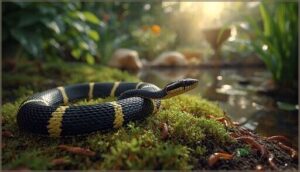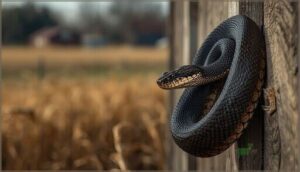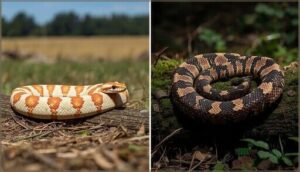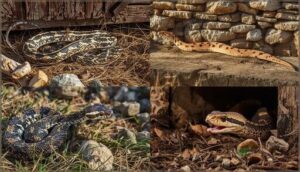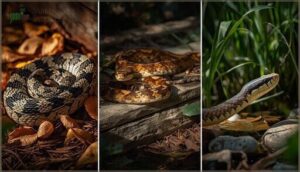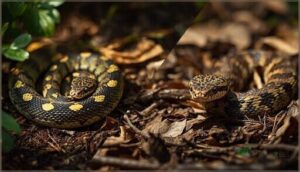This site is supported by our readers. We may earn a commission, at no cost to you, if you purchase through links.
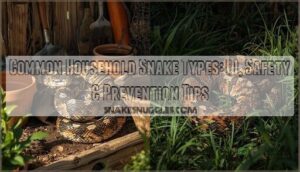
The real challenge isn’t the snake itself—it’s knowing which ones belong to that safe majority and which demand immediate caution. Garter snakes, rat snakes, and other non-venomous species actually serve as your property’s pest control crew, while venomous copperheads and rattlesnakes require a different response entirely.
Understanding what you’re looking at transforms panic into informed action, whether you’re dealing with a helpful garden visitor or a genuine safety concern.
Table Of Contents
Key Takeaways
- Most snakes found around homes (about 85%) are non-venomous species like garter snakes, rat snakes, and corn snakes that actually help control rodent populations, making them beneficial rather than threatening.
- Venomous species near residences—primarily copperheads, cottonmouths, and rattlesnakes—can be identified by triangular heads with vertical pupils, stocky bodies, distinctive color patterns, and defensive behaviors like rattling or mouth-gaping.
- Snakes are attracted to properties offering shelter (tall grass, woodpiles, rock borders) and abundant prey, with unmaintained yards reporting 2.4 times more snake encounters than well-maintained properties.
- Prevention works best through habitat modification (trimming grass to 2-4 inches, removing debris), sealing entry points as small as a quarter-inch, and installing snakeproof fencing buried at least three inches deep for 90% effectiveness.
Common Non-Venomous Household Snakes
Most snakes you’ll find around your home aren’t dangerous at all. In fact, many non-venomous species actually help keep rodent populations in check.
Let’s look at the most common harmless snakes you’re likely to encounter and how to recognize them.
Garter Snakes: Identification and Habits
You’ll recognize garter snakes by their distinctive stripes—usually yellow or red—running the length of their dark bodies. Most adults measure 55 to 86 cm, with females outweighing males at around 150 g.
Key identification features:
- Three longitudinal stripes on keeled scales
- Active during daylight in gardens and near water
- Feed on earthworms, insects, and amphibians
- Bear live young in late summer (7–80 per litter)
- Emit musky secretion when threatened but harmless to humans
Garter snakes are often found in areas with suitable wildlife habitat conditions.
Rat Snakes: Appearance and Pest Control Benefits
While garter snakes patrol your garden, rat snakes tackle bigger problems—rodents. Adults reach 106–183 cm and display shiny black scales with a checkerboard belly and cream throat. Juveniles show gray coloring with brown blotches.
| Feature | Juvenile | Adult |
|---|---|---|
| Color | Gray with brown blotches | Shiny black dorsally |
| Belly | Sandy-gray with dark squares | Checkerboard pattern |
| Length | Variable | 106–183 cm (42–72 in) |
Their climbing ability and adaptive hunting strategies make them highly effective at pest control. You’ll find them in woods, farmlands, and even attics—anywhere rodents congregate. Rat snakes exhibit impressive rat snake growth patterns as they mature.
Corn Snakes and Milk Snakes: Distinguishing Features
You might confuse corn snakes with milk snakes at first glance—both are nonvenomous snakes that rely on constriction methods. Corn snakes reach 61–182 cm with large rectangular blotches and checkerboard bellies, while milk snakes grow to about 90 cm with tri-color banding. Snake coloration and pattern morphs vary widely due to genetic diversity.
Corn snakes prefer exposed areas; milk snakes favor secluded habitats, making snake identification easier once you know habitat preferences.
King Snakes, Bullsnakes, and Gopher Snakes
King snakes, bullsnakes, and gopher snakes are nonvenomous snakes you’ll spot near barns, woodpiles, and stone walls.
King snake diet includes rodents and other snakes—even venomous ones—making them allies in pest control. Bullsnake defense mimics rattlesnakes through tail vibration and hissing, though they’re harmless. Gopher snake ecology centers on burrowing and rodent hunting.
Snake behavior and habitat preferences help with snake identification around your property.
Venomous Snakes Found Near Homes
While most snakes you’ll encounter around your home are harmless, a handful of venomous species do show up in residential areas across North America. Knowing how to identify these snakes can make the difference between a safe observation and a dangerous encounter.
Let’s look at the venomous species you’re most likely to find near your property and how to tell them apart from their non-venomous cousins.
Copperheads: Markings and Risks
You’ll find copperheads throughout the eastern and southeastern U.S., especially from Texas to New England. Their copper-toned bodies display distinctive hourglass-shaped crossbands—wider at the sides, narrow along the spine. Juveniles sport bright yellow tail tips.
While copperhead bites account for most venomous snake encounters in these regions, the venom effects are usually localized swelling and pain, with fatalities extremely rare at just 0.01%.
Cottonmouths: Behavior and Identification
Cottonmouths—sometimes called water moccasins—prefer swamps and slow-moving wetlands across the southeastern U.S. Their distinctive defensive posture involves gaping that bright white mouth and vibrating the tail when threatened.
You’ll recognize adults by their thick bodies with dark bands and tendency to stay near water. Despite their reputation, these venomous snakes rarely bite unless provoked. Most envenomations cause swelling but remain non-fatal with proper treatment.
Rattlesnakes: Types and Warning Signs
Rattlesnakes account for roughly 41% of hospitalized venomous snake bites across the U.S., with western diamondback and timber rattlesnakes most common near homes.
You’ll hear their distinctive warning before seeing them—rattles vibrate at 40 Hz initially, jumping to 60–100 Hz as you approach. This defensive posture includes tail vibration, coiling, and head elevation, giving you time to back away safely.
Differentiating Venomous From Non-Venomous Species
When you’re face-to-face with a snake, venom detection hinges on reading three unmistakable signals your body’s already primed to catch.
Venomous snake identification relies on:
- Head shape and pupils – Triangular heads with vertical slits mark pit vipers, while nonvenomous snake species show rounded profiles and circular pupils.
- Color patterns and body build – Diamond or banded markings on stocky frames signal danger; slender builds suggest harmless species.
- Defensive postures – Coiling, hissing, and mock strikes escalate faster in venomous snakes, though some harmless species mimic these behavior cues for safety.
Snake Habitats Around The Home
Snakes don’t wander into your yard by accident—they’re drawn to specific features that offer shelter, food, and safety. Understanding where these reptiles prefer to hide and what attracts them helps you identify high-risk areas around your property.
Let’s look at the most common habitats that bring snakes close to home.
Typical Snake Hideouts in Yards and Gardens
You’ll commonly encounter backyard snakes in areas offering shelter and concealment. Tall grass and overgrown shrubs harbor snakes in over 63% of sightings, while woodpiles and garden debris create ideal hideouts. Rock borders, ornamental stonework, and animal burrows provide additional cover.
Snake habitats thrive where yard maintenance lapses—properties with unmaintained areas report 2.4 times more encounters than well-trimmed yards.
How Food Sources Attract Snakes
Snakes follow their stomachs, and your yard’s food web determines snake attraction. Rodent populations drive over 75% of household snake presence—when mice thrive on spilled bird seed or fallen fruit, predators like rat snakes and kingsnakes follow.
Insect populations in moist areas draw garter snakes, while food waste increases rodent activity by 1.8 times. Effective rodent control disrupts this prey-predator cycle, reducing snake habitats.
Seasonal Patterns of Snake Activity
Understanding when snakes appear helps you anticipate encounters. Snake migration follows temperature effects closely—most species emerge from brumation patterns between March and April when daytime temps exceed 68°F. Activity peaks from June through August, with July accounting for 22% of annual sightings.
Humidity impact drives additional encounters during spring rains, while cooler fall temperatures trigger dormancy preparation and reduce snake habitats around homes.
Identifying Snakes Safely
Knowing how to identify a snake from a safe distance can help you respond appropriately and avoid unnecessary panic. You don’t need to be an expert to recognize the most important features that separate harmless species from venomous ones.
The following guidelines will show you what to look for and how to observe snakes without putting yourself at risk.
Key Visual and Behavioral Cues
Before you approach a snake, watch how it reacts. Defensive postures like body compression or an elevated head signal readiness to strike.
Warning signals such as rattling, hissing, or hooding help with snake identification and tell you it feels threatened. Rattlesnake behavior often includes tail vibrations before biting.
Reading snake body language and threat displays keeps you safe around venomous snakes.
Using Color Patterns and Body Shape
Once you’ve noted defensive behavior, shift your focus to color pattern recognition and body shape analysis. Longitudinal stripes often mark fast, active species like garter snakes, while transverse bands indicate ambush hunters—frequently venomous snakes. Bright reds and yellows signal danger or pattern mimicry in species identification.
Body shape analysis matters too: slender forms suggest climbers, sturdy builds point to ground dwellers, aiding accurate snake identification.
Mistaken Identity: Common Lookalikes
Color pattern recognition isn’t foolproof—species confusion runs high even among seasoned observers. Juvenile rat snakes with gray blotches trigger identification errors because they mimic copperheads, though only copperheads flaunt sulfur-yellow tails.
Snake mimicry complicates things further: milk snakes and kingsnakes sport coral snake bands, fooling people 42% of the time. Venomous lookalikes exist everywhere, so you’ll need more than body shape to nail snake identification accurately.
Safe Observation Practices
Safe distancing matters most when you’re dealing with any snake near your home. Stay at least 6 feet back—snakes strike up to two-thirds their body length, and nearly all bites happen within arm’s reach.
Always keep at least six feet between you and any snake—most bites happen within arm’s reach
Use binoculars or your phone camera for visual identification, observe behavioral cues like coiling or tongue flicking, and keep emergency protocols handy. Never attempt physical contact.
Preventing and Managing Household Snakes
You don’t have to live in fear of finding a snake coiled up in your garage or slithering through your garden. With the right preventive measures, you can make your property far less attractive to these reptiles and greatly reduce unwanted encounters.
Let’s explore practical strategies that address entry points, deterrents, professional intervention, and long-term habitat modification.
Sealing Entry Points and Yard Maintenance
Snakes can slip through openings as narrow as a quarter-inch, so you’ll want to inspect your foundation carefully. Use sealant materials like silicone caulk for tight gaps and steel mesh for larger holes around utility lines.
Yard maintenance and pest control go hand-in-hand—trim grass to 2–4 inches, clear debris within six feet of your home, and consider snakeproof fencing and barrier installation buried three inches deep for outdoor safety and snake prevention.
Natural and Physical Deterrents
Beyond structural fixes, you can layer in natural snake deterrents like repellent plants—marigolds and lavender offer modest benefits depending on species—and essential oils such as cinnamon or clove, though their effectiveness drops sharply after six hours. Physical barriers remain the benchmark:
- Install snakeproof fencing at least three feet high with buried edges
- Use barrier materials like fine-mesh metal with openings under 1/4 inch
- Skip ultrasonic devices—they lack consistent scientific support
Snake repellent and snake deterrents work best when combined with habitat modification.
When to Seek Professional Snake Removal
If you spot a snake indoors, near high-traffic areas, or can’t confidently rule out venomous snakes, professional help is your safest move. Emergency services handle 29% of removals involving venomous species, where snake bite risks climb sharply.
Removal costs average $340, rising to $600 for urgent cases or hard-to-reach spots, but wildlife experts deliver proven prevention methods and peace of mind.
Creating a Snake-Resistant Environment
Think of your yard as a fortress—habitat modification forms the first line of defense. Keeping grass trimmed to 2–3 inches and removing debris piles cuts snake presence by 62%, while snake-proofing with 3-foot fencing buried 4–6 inches deep achieves 90% prevention.
Yard sanitation, barrier installation, and sealing gaps under ¼ inch turn backyard snake control into wildlife control reality.
Frequently Asked Questions (FAQs)
What do snakes eat in residential areas?
Your backyard is practically a buffet for hungry serpents. In residential areas, snakes usually hunt rodents like mice and rats, along with amphibians, insects, and small reptiles—forming essential links in local food chains.
How long do household snakes typically live?
Your household snakes’ lifespan depends on species and environment. Non-venomous varieties like corn snakes and milk snakes live 15 to 20 years with proper captive care, while wild populations face shorter lifespans due to predation and habitat challenges.
Can snakes climb walls or enter attics?
Yes, snakes climb walls and enter attics using belly scales that grip textured surfaces like brick and stucco. They access roofs through gaps, vents, and tree branches, seeking warmth and rodent prey.
Are baby snakes more dangerous than adults?
Baby venomous snakes pack more potent venom per bite, but adults deliver far greater venom yield—often twenty to fifty times more.
Both pose real danger, requiring immediate medical attention and proper snake identification for effective bite prevention.
Do snakes travel in pairs or groups?
Most snake species are solitary, but garter snakes form surprising social groups centered around older females.
These communities can include up to 46 individuals during breeding seasons, with structured hierarchies guiding collective movement and communication.
Conclusion
Think of snake awareness like learning a new neighborhood—initial uncertainty fades once you recognize the regulars. Your yard’s reptilian residents, whether harmless garter snakes or more concerning copperheads, follow predictable patterns that informed observation reveals.
Identifying common household snake types transforms that shed encounter from panic into measured response. Habitat modification, combined with respectful distance, keeps both you and these misunderstood predators safely coexisting.
Knowledge replaces fear when you understand what’s actually slithering through your garden.
- https://www.forbes.com/sites/scotttravers/2025/10/11/a-herpetologist-reveals-the-4-most-popular-pet-snakes-and-gives-advice-for-choosing-yours/
- https://www.petmd.com/reptile/popular-pet-snake-species
- https://www.chewy.com/education/reptile-and-amphibian/snake/best-pet-snakes
- https://www.britannica.com/animal/house-snake
- https://americanpetproducts.org/news/from-bigger-tanks-to-stronger-bonds-fish-reptile-ownership-evolves-in-2025

